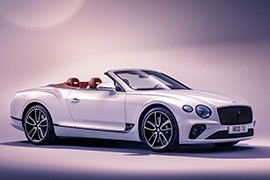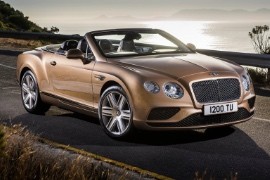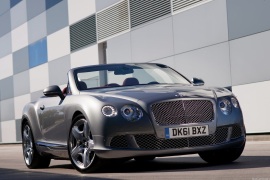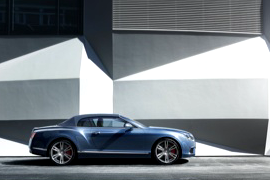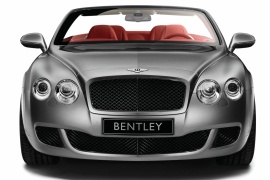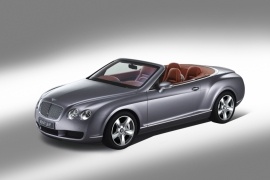BENTLEY Continental GTC Models/Series Timeline, Specifications & Photos
First production year: 2006
Engines: Gasoline
Body style: Convertible (spider/spyder, cabrio/cabriolet, drop/open/soft top)
The third generation of the Bentley Continental GT was launched at the 2017 Frankfurt Motor Show. One year later, in November, the Convertible version was shown. It might seem strange to see an open-top vehicle launched when winter was coming (along with the 8th sequel of the Game of Thrones), but it was the right moment since the waiting period between order and delivery took just about enough for the car to be ready in the spring.
The 2.5-ton vehicle was based on the GT model and shared the same platform with the Porsche Panamera. Compared to the previous generation, the 2018 GTC was lighter by around 80 kg (176 lbs) and more powerful. The 6.0-liter W12 engine was offered with more power, offering 635 hp, 60 hp more than before. The torque has been increased too, from 700 Nm (516.3 lb-ft) to 900 Nm (663.8 lb-ft). As a result, the 0-100 kph (0-62 mph) sprint was obtained in 3.8 seconds, which is supercar territory.
But the GTC was an open-top Granturismo, built for relaxed driving. It doesn't have a big trunk. The interior features are top quality, with beautifully crafted leather, custom stitches with designated colors. But the feature that attracts the biggest applause was the Bentley Rotating Display in the middle of the dashboard, which is like in a 007 movie when at a touch of a button a panel rotates and reveals a 12.3” touch-screen, and on the other side there are three analog dials.
In 2017, Bentley unveiled the fastest four-passenger convertible ever made to that date: the GTC Supersports.
With a long motorsports history to back it up, Bentley focused on high-performance luxury vehicles. Since it was part of the Volkswagen Group, it had access to the latest technologies from Audi and Porsche, other companies that wrote motorsports history books. So it was no surprise for the British brand to try and succeed to offer top luxury and performance vehicles for those who asked for it. On top of that, the carmaker decided to cut the roof and offer the Continental with an open top for relaxed or spirited driving experiences.
Bentley designers reshaped the GTC range and changed the front part of the car to look more aggressive. The black accents on the hood-vents, mesh-grille, side-intakes, and the lower lip spoiler made the car looks like it was made to burn the roads ahead. On the front fenders, the carmaker installed an additional set of black-painted vents. In the rear, a redesigned bumper allowed the slim oval, black pipes to get through the diffuser. The soft top was completely retractable behind the rear seats at the touch of a button.
Inside, Bentley used a unique color split that has been created, using three colors: the first tri-tone interior offered in this generation Continental GT. A new diamond-quilted design was incorporated in the seats and door side panels, while chequered Supersports carbon-fibre fascia panels joined the existing list of ten veneers and technical finishes available. The interior was completed by new Supersports emblem stitching, steering wheel, and gear lever.
Under the hood, Bentley installed the W12 bi-turbo engine, good for 710 hp. It sent the power in all corners via an 8-speed automatic transmission.
The Bentley Continental Grand Tourer received a refresh in 2015, which covered more areas from the outside look to the engine power and fuel-efficiency.
In reality, the usual Bentley buyer doesn't care about fuel consumption. The only problem would be the range, but for that, there is plenty of gas-station on the way. What a Bentley owner cares more was the look of the car. The 2015 Bentley should look different than the “old” 2012 Bentley, even if it was the same model.
On the front of the 2015 Continental GTC, there was a new bumper, new grille, and a smaller radiator shell. On the front fenders, there was a new side vent with a B-badge as decoration. In the rear, there was a more sculpted trunk lid, with a pronounced aerodynamic profile to the edge. The rear bumper was also redesigned and it was wider. A new diffuser was installed for the V8S and GT Speed to further differentiate the performance-focused members of the Continental lineup.
Inside, the visual upgrades were continued. There was a new straight-fluting pattern on the seats, while the Mulliner Driving Specification gained a tightened, “small-diamond” quilted pattern. Since the car was more sports-orientated, there a pair of larger paddles-shifters were installed.
For the engines, there was e new technology to deactivate the cylinders. Thus, the V8 would run on a 4-cylinder and the W12 could run as a V-4 engine. But the driver will not know. Bentley didn't put any special light to announce that. Maybe because a Bentley driver is not concerned about the fuel-efficiency.
Bentley has been making open-top grand tourers for almost a century when it unveiled the 2013 Continental GTC at the 2012 North American International Auto Show.
The British automaker introduced the second generation of the Continental in 2011 in coupe shape and waited for another year before revealing the open-top version of it, namely the GTC. It was created to provide comfortable rides on long distances, with the top up or down, depending on occupants' moods and weather. Even though it didn't have any problem providing a retractable hard-top solution, the automaker considered that a triple-layer canvas top was much more appropriate to the customers of the luxurious convertibles segment.
While at first sight, it didn't look like a new vehicle, there were significant changes to the car. No panel was similar to the ones installed on the previous generation of the GTC. At the front, it also featured four headlights but with a sleeker design and integrated LEDs for the daytime running lights that looked like luminescent pearls. The mesh grille on the upper grille was complemented by a set of three lower air intakes that increased the cooling area. From its profile, the car shared several parts with its coupe sibling, such as the front fenders and door panels. Still, the A-pillars that supported the windshield were thicker and served as roll-over protection. At the back, the GTC sported a flat deck, and underneath the bumper, the automaker placed two thin elliptical chromed exhausts.
The cabin boasted a high level of luxury, featuring leather-wrapped seats. At the front, there was a set of bolstered bucket seats, while in the back, the GTC was fitted with a bench seat profiled for two. Due to the compartment for the retractable roof, legroom was smaller than in the GT Coupe but was still enough for adults, mostly on short jaunts. The driver fronted a dashboard adorned with metallic trims and a binocular-style instrument cluster where the tachometer and the speedometer flanked a TFT display and two additional gauges for fuel level and water temperature. On the center stack, the automaker installed a touchscreen for the infotainment system.
Under the hood, the automaker installed a choice of four engines ranging from 507 PS (500 hp) to 635 PS (626 hp) V8 or W16, respectively. Interestingly, the V8 twin-turbocharged powerplant featured an active cylinder deactivation system that allows the car to run on a V4 scheme. Power for all versions went into all four corners via an eight-speed automatic transmission. Bentley knew that some of its customers would just want to cruise slowly on highways or in cities while others would want to check the vehicle's top speed, so it offered its customers every new piece of technology that it had in its sleeves.
Introduced at the 2010 Paris Motor Show, the second generation of the Continental GT under VW management thrived for attention and opened the check-books.
A year after its coupe sibling was introduced, the open-top version came to enhance the lineup. The Gran Turismo Cabriolet version of the coupe added more appeal to the car and featured the same luxurious interior. The time-gap between the coupe and the convertible version was needed to design and produce the best solution for the big barge. It had to look good either covered or with the top down. The seven-bow, three-layer fabric roof was available in eight different colors. It took only 25 seconds to fold or cover the car.
With the already established four-round headlights and the big grille was available in black or silver. A wide grille was installed in the apron and was complemented by two side air-intakes to cool the brakes. The dashboard evoked the flying wings of the Bentley motif. For the infotainment system, Bentley installed an 8” touch-screen monitor on the center stack. The navigation was HDD based, but if necessary a DVD was provided for other areas. It was Google Maps-compatible in some markets.
For the engine compartment, the 2011 GTC was offered with a twin-turbo W12 unit carried-over from the previous generation was present, but with 15 more hp. It was still mated to a 6-speed automatic.
Bentley refreshed its entire lineup for the 2009 model and introduced more powerful engines for its cars, including a Speed version for the GTC.
Do you know that saying with "New Year, new me"? For Bentley, that was true. It had to adapt its products to the Euro 5 emission rules and, along with the upgraded engine, it added some aesthetic tweaks to its cars. For the open-top Continental, it introduced the Speed version powered by Volkswagen's W12 engine.
There was a striking difference at the lower bumper area at the front, where the design team enlarged the center air-intake and filled it with a mesh-grille design, and applied the same pattern for the side-scoops. The radiator's grille was more upright, while the headlamps featured chrome bezels.
Inside, the GTC Speed's cabin was based on the Mulliner Driving Specification fitted as standard. It featured diamond quilted hide seats with embroidered Bentley emblems. Its three-spoke multi-function steering wheel featured brushed aluminum switches surroundings. To further resemble the brand's racing heritage, Bentley installed drilled alloy pedals and "Speed" logos on the treadplates.
Under the hood, the carmaker installed the most powerful version of the 6.0-liter W12 engine. Fed by a pair of turbochargers, it developed 610 horses, which were sent in all corners via a 6-speed automatic transmission. For the Speed version, the carmaker installed carbon-ceramic brakes and a stiffer suspension.
Bentley Continental was the first model launched by Bentley after it was acquired by Volkswagen Group. It was introduced in 2003 and evolved into more versions.
The convertible version of the Continental GT was exhibited in public for the first time at the 2006 New York International Auto Show. Bentley always had convertible vehicles in its lineup and the GTC was a mandatory addition to the British stable. It wasn't long until the result gained attention. Its front fascia was the same as the coupe version, but from the A-pillars behind everything was changed.
In order to build a big convertible with loads of power under the hood, the entire structure had to be reworked and strengthened. The sills, cross-braces for the front and rear suspension, and the A-pillars had to be re-worked to stop the body from flexing. As a result, 110 kg were added to the initial weight. Considering that the motors needed for the canvas top added some to the weight, it means that the engineering research in high-strength materials paid off. With the roof closed, the car had a three-box shape.
Inside, the opulent interior with expensive leather and materials were the same used for the closed version. The rear seats offered enough headroom with the roof down, but very little room for the legs.
Under the hood, there was the same drivetrain from the coupe version, with the same great W12 engine mated to a 6-speed automatic transmission and an all-wheel-drive system.
